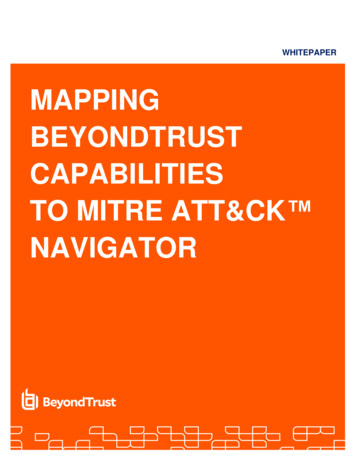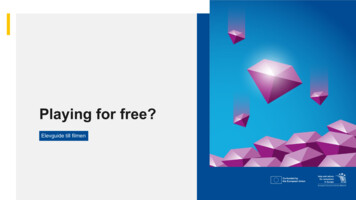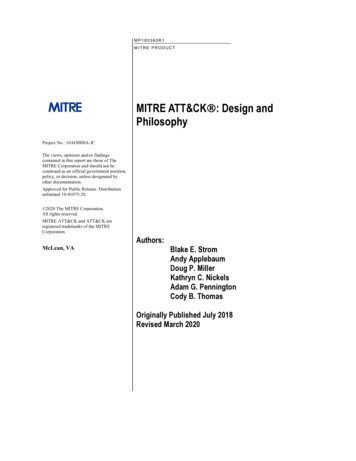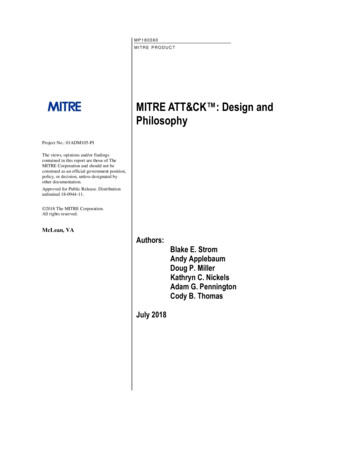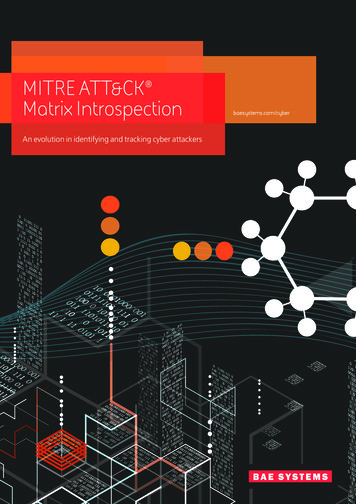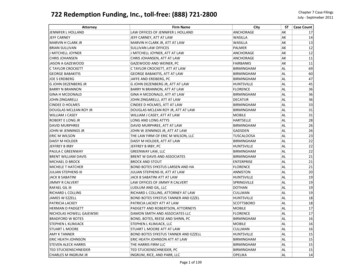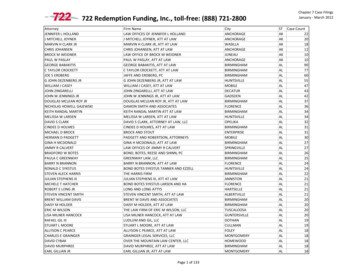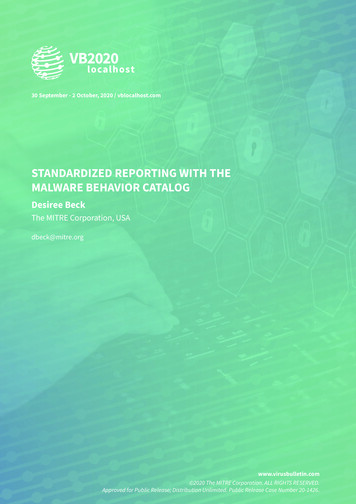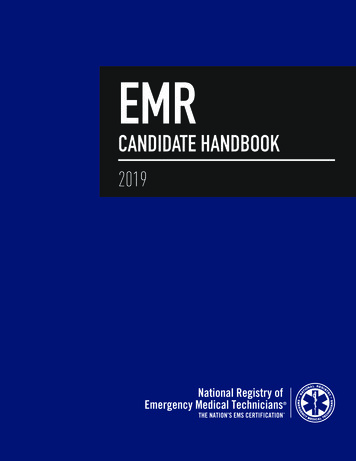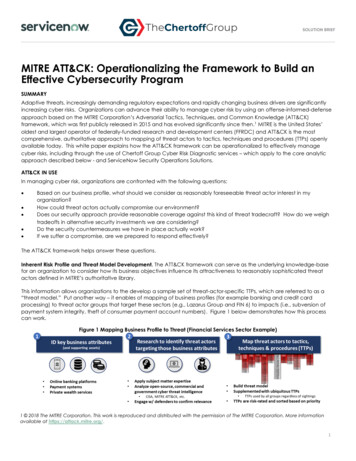
Transcription
MITRE ATT&CK: Operationalizing the Framework to Build anEffective Cybersecurity ProgramSUMMARYAdaptive threats, increasingly demanding regulatory expectations and rapidly changing business drivers are significantlyincreasing cyber risks. Organizations can advance their ability to manage cyber risk by using an offense-informed-defenseapproach based on the MITRE Corporation’s Adversarial Tactics, Techniques, and Common Knowledge (ATT&CK)framework, which was first publicly released in 2015 and has evolved significantly since then.1 MITRE is the United States’oldest and largest operator of federally-funded research and development centers (FFRDC) and ATT&CK is the mostcomprehensive, authoritative approach to mapping of threat actors to tactics, techniques and procedures (TTPs) openlyavailable today. This white paper explains how the ATT&CK framework can be operationalized to effectively managecyber risks, including through the use of Chertoff Group Cyber Risk Diagnostic services – which apply to the core analyticapproach described below - and ServiceNow Security Operations Solutions.ATT&CK IN USEIn managing cyber risk, organizations are confronted with the following questions: Based on our business profile, what should we consider as reasonably foreseeable threat actor interest in myorganization?How could threat actors actually compromise our environment?Does our security approach provide reasonable coverage against this kind of threat tradecraft? How do we weightradeoffs in alternative security investments we are considering?Do the security countermeasures we have in place actually work?If we suffer a compromise, are we prepared to respond effectively?The ATT&CK framework helps answer these questions.Inherent Risk Profile and Threat Model Development. The ATT&CK framework can serve as the underlying knowledge-basefor an organization to consider how its business objectives influence its attractiveness to reasonably sophisticated threatactors defined in MITRE’s authoritative library.This information allows organizations to the develop a sample set of threat-actor-specific TTPs, which are referred to as a“threat model.” Put another way – it enables of mapping of business profiles (for example banking and credit cardprocessing) to threat actor groups that target these sectors (e.g., Lazarus Group and FIN 6) to impacts (i.e., subversion ofpayment system integrity, theft of consumer payment account numbers). Figure 1 below demonstrates how this processcan work.Figure 1 Mapping Business Profile to Threat (Financial Services Sector Example)1 2018 The MITRE Corporation. This work is reproduced and distributed with the permission of The MITRE Corporation. More informationavailable at https://attack.mitre.org/.1
How ServiceNow helps: Inputs for this mapping may come from: Business Impact Analysis (BIA) to define critical services/functions and related key business attributes. BIAs aredeveloped and maintained within ServiceNow’s Business Continuity Management application, which has a naturalintegration with ServiceNow’s Security Operations applications.Reporting from cyber threat intelligence sources (government, commercial, open source). The Threat Intelligencemodule in ServiceNow’s Security Incident Response (SIR) application supports STIX 1.X and 2.X data models. The ThreatIntelligence module can be integrated with many OSINT and Commercial Threat Intel feeds.Incident response reporting for previous incidents, especially when categorized by TTP. SIR captures and categorizesincident response details by TTPs as described in more detail in the “Incident Response Planning and Resiliency”section below.Threat model mapping using Security Incident Response. The Threat Intelligence module in Security Incident Responseincludes support for the MITRE ATT&CK framework. Threat Intel Analysts can analyze threat intelligence data within SIR.Security teams can map TTPs to Threat Actors. SIR’s Case Management module allows security teams to create new casesbased on ‘Threat Actor’ profile or ‘Campaigns’, as depicted in Figure 2 below. Artifacts like incidents, observables, IOCs,users, and configuration items can be added to the Threat Intel cases for deeper investigation.Figure 2: Adversary ProfileAdversary behavior can also be viewed in the form of a threat pathway or “kill chain” threat model view using the SecurityIncident Response MITRE ATT&CK Navigator and heatmap, as depicted in Figure 3 below.2
Figure 3: Threat Model ViewMapping to Defensive Countermeasures. Organizations can next map their current defensive countermeasures to TTPsidentified in their newly-developed threat models. By overlaying a coverage map with a threat model, defenders gain anunderstanding of what technologies and standards applied in their environments are potentially addressing what TTPs. TheATT&CK framework provides a mechanism to support this mapping through the “data sources” and mitigations ascribed toeach TTP contained in the ATT&CK framework.2Notably, not all relevant threat techniques represent the same level of risk, and additional open source and proprietarydata sets can be leveraged to prioritize TTPs based on risk reduction value. Key input factors include ease of attack,difficulty of defense and other organization-specific considerations.Ultimately, the TTP-coverage map also gives a defender the capability to prioritize future, defensive countermeasureinvestments based on risk reduction value. The data adds further depth to the overlays we just described: now, we can notonly see whether a countermeasure provides broad coverage against TTPs, but also the extent to which it covers critical orhigh priority TTPs.How ServiceNow helps: By mapping TTPs in ATT&CK to data sources and detection tools, ServiceNow Security Operationsallows organizations to identify which attack techniques are relevant to them, prioritize the impact, assess how well they candetect and respond to attacks, track progress and measure improvement, and create visualizations for teams managingthat effort and executives who need to be provided metrics. Gaining visibility into detection and response coverage of the organization on the attacker techniques. ServiceNowSecurity Incident Response has an out-of-the-box feature that supports mapping of ‘data sources’ and ‘detectiontools’ to MITRE ATT&CK TTPs, as described in Figure 4 below. Detection coverage for the techniques used by relevantadversaries can be viewed in the form of a heatmap. This gives visibility into the security posture of a companyagainst the targeted attacks by known adversaries.2 This overlay can also, in principle, be mapped to authoritative frameworks, and MITRE’s Center for Threat Informed Defense has recentlyreleased an authoritative mapping to NIST Special Publication 800-53. See: a074f64a.3
Figure 4: Threat Model View – Detection Coverage Mapping and RatingThis exercise gives visibility into event data sources, their relevance to an organization, and helps identify gaps in thecoverage. Figure 5 below describes a table view of how data sources are correlated to TTPs. Organizations can enhancetheir environment by investing in collecting the right data sources for the right threats, and in optimizing or acquiring relateddetection tools.Figure 5: Table View – Data Source to TTP CorrelationThe solution can be also extended to map the defensive countermeasures based on risk reduction value.4
Detection Assurance Testing. There is often a lack of clarity on what types of threat activity a defensive measure actuallyaddresses, particularly depending on how it is configured and implemented; thus organizations can meaningfully strengthentheir programs by validating the extent of protective and detective capabilities’ performance against simulated threatactivity. Testing scripts have already been developed specific to each of the MITRE ATT&CK techniques, and these scriptscan be leveraged to validate and hone defenses.Security teams can use third-party services, automated testing tools or Breach and Adversarial Simulation (BAS) products totest their defenses. BAS tools are now available that can run TTP-specific diagnostics on an organization’s technology stack.This process enables organizations to continuously validate that security controls are operating effectively, and to revealunknown weaknesses like misconfigured security controls, unknown vulnerable assets, or ambiguous detection rules thatneed attention. The outcome of the exercise also reveals the overall technique detection coverage, prevention, anddefensive capabilities. To implement testing, an organization can select a sample of assets/images that reflect both “crown jewel”considerations and machines that may be representative of IT environment as a whole. The diagnostic assessmentswould be conducted on these sample sets.We now have both really precise data on countermeasure coverage (based both on breadth and criticality of TTPsaddressed) and really accurate data on countermeasure performance (TTP-specific pass/fails on testing). Usingmath, this data can be converted into weighted numerical values (a low value TTP might be a “3” where a highpriority TTP might be a “10”). Results can then be aggregated to generate an overall risk score – for example (A-F, 0100, 300-850, etc.). Results can be tracked over time to generate performance data and trending insights.It is also possible to generate reporting that demonstrates the potential positive impact of investment in a tool orstandard on security performance. Such insights are invaluable when considering the costs and benefits of futuresecurity investments.How ServiceNow helps. Organizations can reflect test results in ServiceNow’s MITRE ATT&CK ‘overall technique detectioncoverage’ mapping feature, described above in the “Defensive Countermeasures” section above. As described in Figure 6below, coverage can be classified as Excellent, Fair or Poor.Figure 6: Detection Coverage Effectiveness Classification5
Improve red team/blue team collaboration and ROI. The combination of the ServiceNow Security Operations Platform andMITRE ATT&CK Framework provides a template for collaboration. Red team members can test against specific tactics andtechniques or emulate a known threat actor while blue teams have the right visualization into controls and data sources toisolate areas that need improvement. By working with the same tools and models, organizations gain visibility to granularchanges for risk mitigation, and this knowledge can also help guide security investments and improve ROI on securityspending.Incident Response Planning and ResiliencyIn order to achieve resiliency, organizations need to be able to effectively anticipate, withstand, recover and evolve fromattacks. The ATT&CK framework helps advance resiliency capabilities in several key ways: First, ATT&CK can help prioritize response-oriented planning – e.g., to anticipate specific Lateral Movement andPrivilege Escalation techniques, and to withstand specific Defense Evasion techniques.Second, the ATT&CK framework can also be used to categorize incidents that do occur by specific technique, whichcan in turn enable more focused remediation and lessons-learned activities.Third, ATT&CK now enumerates a specific Impact tactic which can inform incident response, business continuity anddisaster recovery plans and playbooks. According to MITRE, the Impact tactic includes techniques that adversariesuse to disrupt availability or compromise integrity by manipulating business and operational processes, including thedestruction or tampering of data.3 It was introduced in part to capture disruptive behavior such as ransomware anddenial of service attacks that are not captured by the other ATT&CK tactics. We can use these insights to plan,implement and maintain impact-oriented countermeasures (back-up and restore functionality, fraud controlmeasures, etc.).Likewise, to help mature incident response and crisis management capabilities, cybersecurity exercises can be utilizedto offer a safe environment to stress test incident response and broader security capabilities.How ServiceNow Security Incident Response integration with MITRE ATT&CK can help SOC teams achieve IR and resilienceobjectivesSecurity professionals are taught to “think like the enemy” by envisioning the tactics and techniques hackers might employ ifthey were attacking an organization. ServiceNow Security Incident Response integration with the MITRE ATT&CK Frameworkcan help achieve this goal by enabling the SOC team to use the MITRE taxonomy to inform detection and responds toadversarial behavior.As described in Figure 7 below, security analysts can record adversary Tactics and Techniques into Security Incidents andvisualize them in the MITRE ATT&CK card.Figure 7: ATT&CK Characterization in Security Incidents3 See, e.g., https://attack.mitre.org/tactics/TA0040/6
Equipped with the MITRE ATT&CK context, security analysts can respond faster to security threats using playbooks.Playbooks can be built easily in Security Incident Response using ‘low code/no-code’ flow designer tech stack.MITRE ATT&CK specific filters and the MITRE ATT&CK navigator in Security Incident Response can be used forcorrelating on-going and past threats in the context of MITRE ATT&CK to see if a more sophisticated attack is in playthat otherwise would have gone undetected.Out-of-the-box widgets also provide insights about the top techniques and tactics seen in an organization’senvironment, as described in Figure 8 below.Figure 8: TTP Sightings within the OrganizationTARGET OPERATING MODEL CONSIDERATIONSATT&CK provides a common language around threat to help align internal stakeholders with direct or indirect cyberdefense responsibilities – e.g., security engineering, incident response, risk, business continuity and disaster recovery andrelated functions, as notionally described further in the table on the following page (specific roles will vary in eachorganization). In other words, ATT&CK provides stakeholders a more precise means of clearly defining known adversarialtradecraft and the state of an organization’s cyber defenses against that behavior.ATT&CK also provides the building blocks for sector-level threat models that could, for example, be developed andmaintained by sector-specific Information Sharing & Analysis Organizations (ISAOs).7
Key RolesInherent Risk Profile Business Line Chief RiskOfficer (CRO) ChiefInformationOfficer (CIO) ChiefTechnologyOfficer (CTO) ChiefInformationSecurity Officer(CISO), Audit ISAOThreat Model ThreatIntelligenceLead SOC ISAO Key QuestionsHow ServiceNow Security Incident Response, ChertoffCyber Risk Diagnostic and MITRE ATT&CK help Based on my businessprofile, what should Iconsider as reasonablyforeseeable threat actorinterest in myorganization? Whichassets are most likely tobe targeted? Ability to map business profile to ATT&CK threatactor groups based on known interest in similarbusiness profiles How could threat actorsactually compromise myenvironment? Ability to map relevant threat actor groups toTTPsAbility to add known incident TTPs to threatmodelAbility to add TTPs reported in cyber threatintelligence reports to threat modelDefensive Coverage MapSecurity Architecture &EngineeringSOCCISO/CROCIO/CTOControls AssuranceSecurity Architecture &EngineeringSOCAuditCISO/CROCIO/CTO Does my securityapproach providereasonable coverageagainst this kind of threattradecraft? How do Iweigh tradeoffs inalternative securityinvestments I amconsidering? Do the securitycountermeasures I havein place actually work? Incident Response & ResiliencySOC If we suffer aBusinesscompromise, am IContinuity/prepared to Business LineISAO Ability to map ATT&CK TTPs to data sources (viaOOTB functionality)Ability to map ATT&CK TTPs to mitigations andcontrolsAbility to evaluate relative coverage ROI forspecific TTPs, data sources and mitigationsTTP-specific tests on assets based on risk can bedone using internal expertise and third-partycybersecurity products and servicesResults can be presented in Security IncidentResponseAbility to map incident response actions to TTPsand impacted assetsAbility to reflect ATT&CK impact-orientedtechniques into defensive strategyAbility to seed exercises with relevant TTPs8
Security teams have been historically challenged in internalizing an adversary’s intent and tradecraft both architecturallyand when dealing with security incidents, and may incorrectly prioritize security incidents without this insight.Now, with this new capability, threats and incidents are mapped to the MITRE ATT&CK framework to provide advancedcontext on attacks. This enables analysts to stay ahead of attackers and reduce the overall attack surface. Likewise, oncea security incident is mapped to a MITRE tactic or technique, security analysts can use the ServiceNow ATT&CK Navigator tovisualize how an individual tactic or technique is used by the numerous adversaries tracked by MITRE. Security analysts nowgain an adversary perspective and a roadmap for investigations, resolution and after-action analysis.WANT TO LEARN MORE ABOUT HOW SERVICENOW SECURITY OPERATIONS HAS LEVERAGED THE MITRE ATT&CK FRAMEWORK?REFER TO THE PRODUCT DOCUMENTATION.WANT TO LEARN MORE ABOUT HOW THE CHERTOFF GROUP HAS OPERATIONALIZED MITRE ATT&CK? REFER TOINFO@CHERTOFFGROUP.COM9
Figure 4: Threat Model View -Detection Coverage Mapping and Rating This exercise gives visibility into event data sources, their relevance to an organization, and helps identify gaps in the coverage. Figure 5 below describes a table view of how data sources are correlated to TTPs. Organizations can enhance
